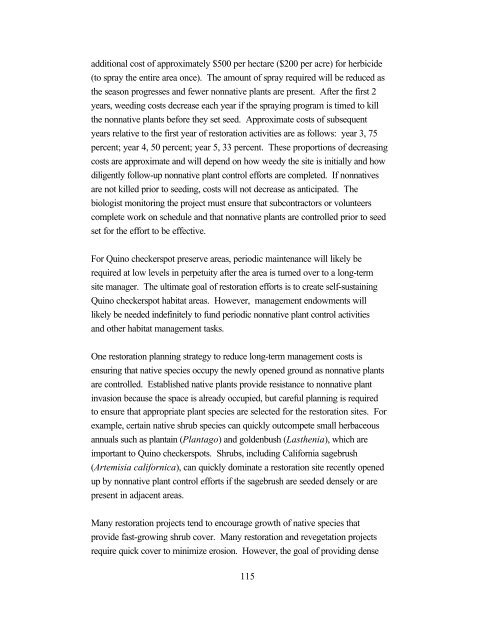Outline of Quino Recovery Plan - The Xerces Society
Outline of Quino Recovery Plan - The Xerces Society
Outline of Quino Recovery Plan - The Xerces Society
Create successful ePaper yourself
Turn your PDF publications into a flip-book with our unique Google optimized e-Paper software.
additional cost <strong>of</strong> approximately $500 per hectare ($200 per acre) for herbicide<br />
(to spray the entire area once). <strong>The</strong> amount <strong>of</strong> spray required will be reduced as<br />
the season progresses and fewer nonnative plants are present. After the first 2<br />
years, weeding costs decrease each year if the spraying program is timed to kill<br />
the nonnative plants before they set seed. Approximate costs <strong>of</strong> subsequent<br />
years relative to the first year <strong>of</strong> restoration activities are as follows: year 3, 75<br />
percent; year 4, 50 percent; year 5, 33 percent. <strong>The</strong>se proportions <strong>of</strong> decreasing<br />
costs are approximate and will depend on how weedy the site is initially and how<br />
diligently follow-up nonnative plant control efforts are completed. If nonnatives<br />
are not killed prior to seeding, costs will not decrease as anticipated. <strong>The</strong><br />
biologist monitoring the project must ensure that subcontractors or volunteers<br />
complete work on schedule and that nonnative plants are controlled prior to seed<br />
set for the effort to be effective.<br />
For <strong>Quino</strong> checkerspot preserve areas, periodic maintenance will likely be<br />
required at low levels in perpetuity after the area is turned over to a long-term<br />
site manager. <strong>The</strong> ultimate goal <strong>of</strong> restoration efforts is to create self-sustaining<br />
<strong>Quino</strong> checkerspot habitat areas. However, management endowments will<br />
likely be needed indefinitely to fund periodic nonnative plant control activities<br />
and other habitat management tasks.<br />
One restoration planning strategy to reduce long-term management costs is<br />
ensuring that native species occupy the newly opened ground as nonnative plants<br />
are controlled. Established native plants provide resistance to nonnative plant<br />
invasion because the space is already occupied, but careful planning is required<br />
to ensure that appropriate plant species are selected for the restoration sites. For<br />
example, certain native shrub species can quickly outcompete small herbaceous<br />
annuals such as plantain (<strong>Plan</strong>tago) and goldenbush (Lasthenia), which are<br />
important to <strong>Quino</strong> checkerspots. Shrubs, including California sagebrush<br />
(Artemisia californica), can quickly dominate a restoration site recently opened<br />
up by nonnative plant control efforts if the sagebrush are seeded densely or are<br />
present in adjacent areas.<br />
Many restoration projects tend to encourage growth <strong>of</strong> native species that<br />
provide fast-growing shrub cover. Many restoration and revegetation projects<br />
require quick cover to minimize erosion. However, the goal <strong>of</strong> providing dense<br />
115
















